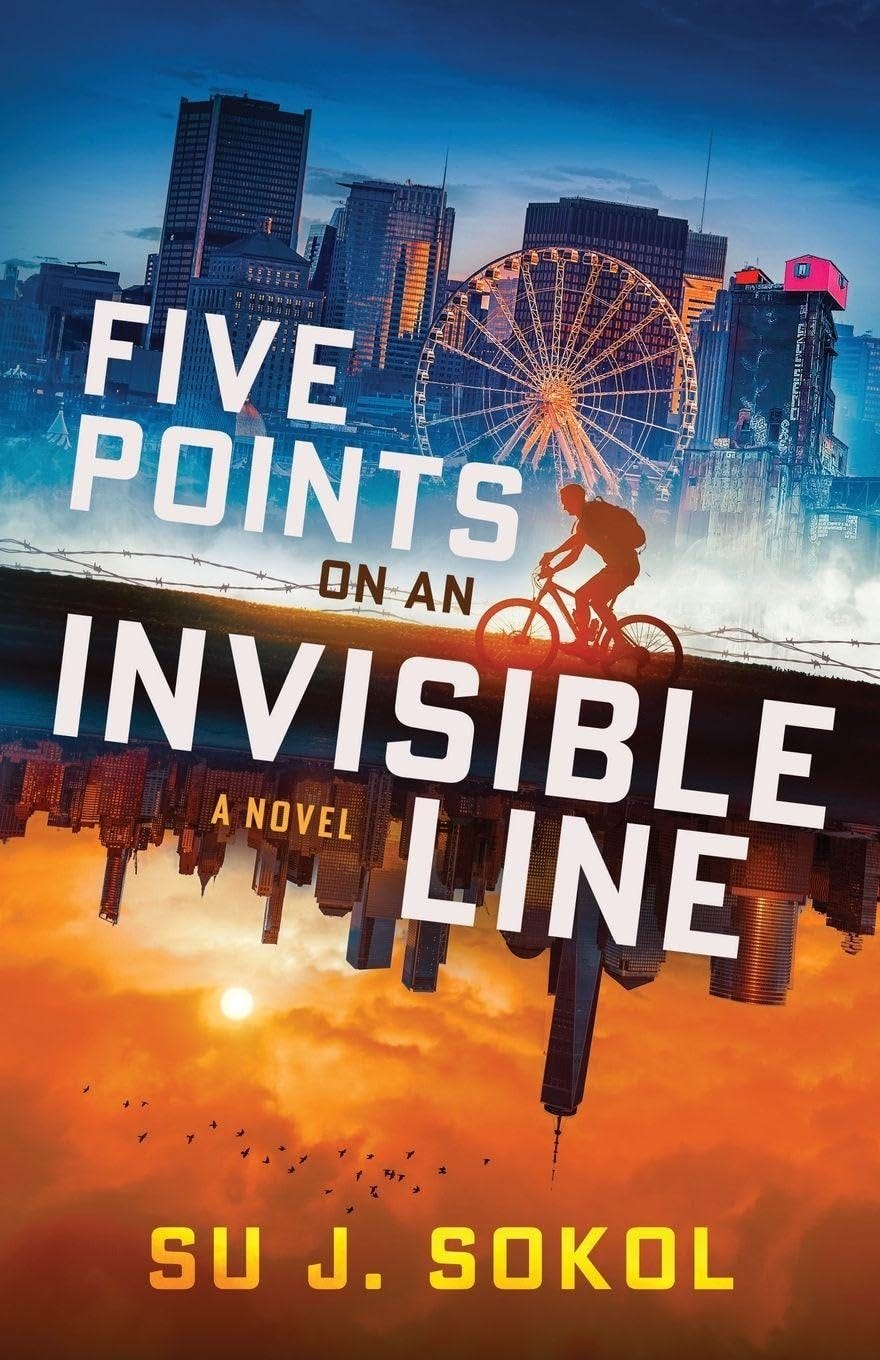Five Points on an Invisible Line by Su J Sokol
Reviewed by Lisa Timpf
Around a decade ago, Montreal writer Su Sokol’s first novel, Cycling to Asylum, was published. In August 2025, Sokol re-released an updated version of Cycling to Asylum titled Invisible Line. Sokol’s newest book, Five Points on an Invisible Line, picks up the story of the characters introduced in the first novel, providing them with new adventures.
As a first novel, Cycling to Asylum was engrossing, offering interesting and relatable characters and an intriguing take on what the world might look like in a darker future. Five Points on an Invisible Line continues the good points of the first novel, providing a complex plot and a slightly larger group of key characters.
In addition to featuring Laek, Janie, and their children Siri and Simon, the main characters in Cycling to Asylum/Invisible Line, Five Points on an Invisible Line gives a larger role to family friend Philip, who joins them in Montréal. Five Points on an Invisible Line offers a multi-layered plot, featuring a polyamorous relationship, a mysterious bombing at an airport, disappearances, and a suspicious death.
“ However, as a work of hopepunk, the book also explores solidarity, activism, and community, and the characters haven’t given up on working toward a better world.”
As Sokol notes in the “Author’s Note on Content,” the novel contains some darker realities, including police violence, PTSD, fight scenes, and other items. However, as a work of hopepunk, the book also explores solidarity, activism, and community, and the characters haven’t given up on working toward a better world. In Janie’s case, that means helping with asylum claims. For Simon, it means doing what he can to support the fight to preserve the natural world.
As someone who has lived in Montréal for a number of years, Sokol is able to generate a strong sense of place. The characters travel mainly by way of public transit or person-power (in the case of Siri, the chosen transportation method is via trottinette, or scooter). This lends a sense of immediacy to the story.
Five Points on an Invisible Line portrays unique issues and scenarios. Janie is an immigration lawyer, so in discussions between her and her colleague Pierre-Ryan, we gain insights into immigration law. We encounter unhoused characters, and people involved in activism. Social justice issues are examined, as well as environmental ones, as Simon and his friend Aiza discuss the plight of endangered species and their own concerns about the future.
Siri, who is attempting to join a youth antifa group, questions whether she has the courage to carry out the group’s initiatives. Laek is faced with a change in leadership where he works, with his new boss appearing unsupportive at best, menacing at worse. Sokol provides a number of tension points, which creates suspense and draws the reader forward.
One of the appealing points of Sokol’s first novel was the likeability of the characters, and the reader’s ability to connect with them. This continues in Five Points on an Invisible Line, perhaps more powerfully as Siri and Simon have grown older and are able to take more initiative.
Five Points on an Invisible Line is also enjoyable for its portrayal of near-future society. It’s a future that isn’t here yet, but it isn’t all that unbelievable, either, which adds to the immediacy and the appeal of the novel.
Those who enjoyed Cycling to Asylum or the updated version, Invisible Line, should find much to like in Five Points on an Invisible Line.
About the Author
Su J Sokol is a social rights advocate, a freelance editor, and a writer of speculative, liminal, and interstitial fiction. A former legal services lawyer from New York City, xe now makes Montréal xyr home. Sokol is the author of three novels: Cycling to Asylum, which was long-listed for the Sunburst Award for Excellence in Canadian Literature of the Fantastic and has been optioned for development into a feature-length film, Run J Run (2019), and Zee (2020), which is available in both English and French. Sokol’s short fiction has appeared or is upcoming in various magazines and anthologies including in The Future Fire, Spark: A Creative Anthology, Glittership: an LGBTQ Science Fiction and Fantasy Podcast, After the Orange: Ruin and Recovery (B Cubed Press), and Amazing Stories.
About the Reviewer
Lisa Timpf lives in Simcoe, Ontario, where she writes poetry, book reviews, short stories, and creative nonfiction. Lisa’s speculative poetry collections Cats and Dogs in Space (2025) and In Days to Come (2022) are available from Hiraeth Publishing in print and electronic formats. Lisa is a member of SF Canada and the Science Fiction and Fantasy Poetry Association. You can find out more about her writing projects at http://lisatimpf.blogspot.com/. Lisa is also on Bluesky, @lisatimpf.bsky.social
Book Details
Publisher: Flame Arrow Publishing
Publication date: Sept. 16 2025
Language: English
Print length: 428 pages
ISBN-10: 1990368247
ISBN-13: 978-1990368240




